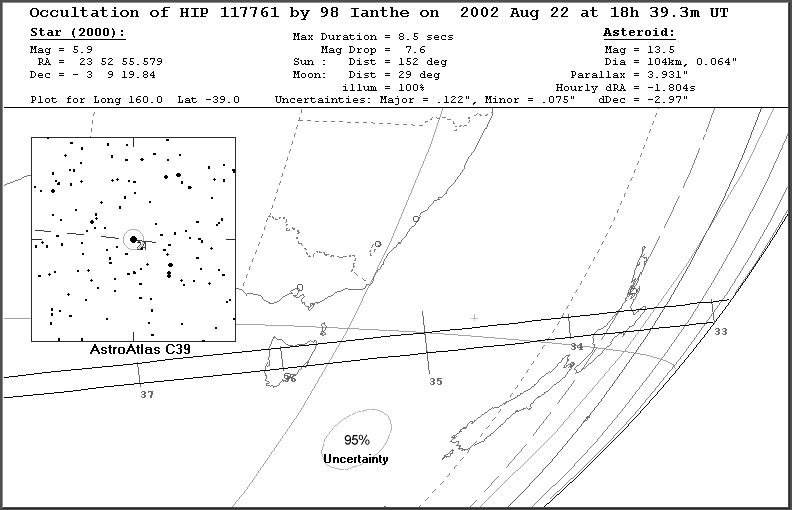ASTROMETRIC UPDATE:
OCCULTATION BY (98) IANTHE - 2002 AUG 22
[OCCULT Prediction + Finder Charts]
UPDATE: 2002 JUL 23, 02:24 UT
THE UPDATED PATH

On the night of 2002 Aug 22 UT (just before dawn on the 23rd), the 104 km diameter asteroid (98) Ianthe will occult a 5.9 mag star in the constellation Pisces for observers along a path across much of Tasmania and the central parts of the North Island of New Zealand right on local sunrise.
The target star for this event is 24 Piscium (magnitude = 5.9). Unfortunately, it is known to be a close double consisting of two magnitude 6.8 components seperated by 0.10" at a PA of 65o. Since (98) Ianthe is expected to subtend no more than 0.06", one star will shine if the other is covered. The actual magnitude drop will therefore be only 0.7 which will be hard to detect visually if the seeing is bad. Some observers may see two occultations as (98) Ianthe passes across both stars. In this case, the two events should be around 12 seconds apart. The maximum expected length of each occultation is around 8.5 seconds.
This update is based on UNSO/Flagstaff astrometry for the asteroid kindly provided by Ron Stone, astrometry for the asteroid kindly provided by Gordon Garradd, historical astrometry from AstDys, and the following catalogs for the star position: Hipparcos .
Additional details of this and other events are available at Steve Preston's website at http://www.oz.net/~stevepr/Asteroids/asteroid.htm
EVENT DETAILS SUMMARY :
- Event Rank : 98
(The event Rank is a measure of the likelihood of observing an event. Currently, the Rank equals
the probability of at least one successful observation by a team of two observers spaced 1/8 path
width just inside opposite sides of the predicted path. This probability is a function of the size
of the asteroid in the sky (in arc seconds), the uncertainty in the position of the asteroid, and
the uncertainty in the position of the star. Eventually, the Rank will also consider factors such
as the brightness of the star, the magnitude drop, and the duration of the event).
- Date and approx. UT time of event : 2002 Aug 22, 18:32 - 2002 Aug 22, 18:45 UT
(Refer to map for your own location)
- Magnitude of target star : 5.9
- Magnitude drop [mag] : 7.6
- Estimated maximum duration [s] : 8.5
- Phase of moon, angular distance : 100 % sunlit, 29° distance
- Sun : 152° distance
- Rough path description : Tasmania (Australia)
The Occultation Path :
- Approximate projected width [km] : 142
- Uncertainty interval [path widths] : +/- 0.35 (1 sigma)
- Uncertainty interval approx RA,DE ["] : (+/- .028 +/- .024) (1 sigma)
- Uncertainty ellipse (major, minor, PA) : ( .031", .019", 55° ) (1 sigma)
- Remarks :
Data for the target star :
- Name : HIP 117761
- Constellation : Pisces
- J2000 position [h,m,s ; °,',"]: RA: 23 52 55.5793 DE: -03 09 19.845
- Position source : Hipparcos
- Standard error : RA,DE ["]: ( .013, .008 )
- V mag [mag] : 5.9
- Remarks : (none)
Data for the minor planet :
- Number, name : (98) Ianthe
- Approx. diameter [km] : 104
- Approx. diameter [arcsec] : .064
- Source of used astrometry : FASTT Garradd Astdys
- Number of used observations : 275
- Number of rejected observations : 36
- Time covered by the observations : 1901 Sep 19 - 2002 Jul 21
- 1 sigma uncertainty ellipse (major, minor, PA) : 0.029, 0.018, 49°
- Remarks :
- Update computed by : Steve Preston, Medina, Washington, USA. (OrbFit).
IMPORTANT NOTE!
Astrometric updates such as these should not be taken as definitive, but rather only as an indication of where the true track may lie relative to the original predicted track. Observers must bear in mind that later astrometry, in which the target star is measured in the same field as the asteroid, may still reveal substantial changes to the predicted track and time of the event. For this reason it is most important that observers far from the predicted track still monitor the event.
Use these links for further information:
[Planetary Occultations]
[Using the Predictions]
[Observing Details]
[Timing Details]
[Reporting Details]
[Report Form]
[Asteroid Occultation Results]
[Site Map]
[What's an Occultation?]
[Total Occultations]
[Grazing Occultations]
[Planetary Occultations]
[Jovian Satellite Eclipses]
[Timing Occultations]
[Reporting Observations]
